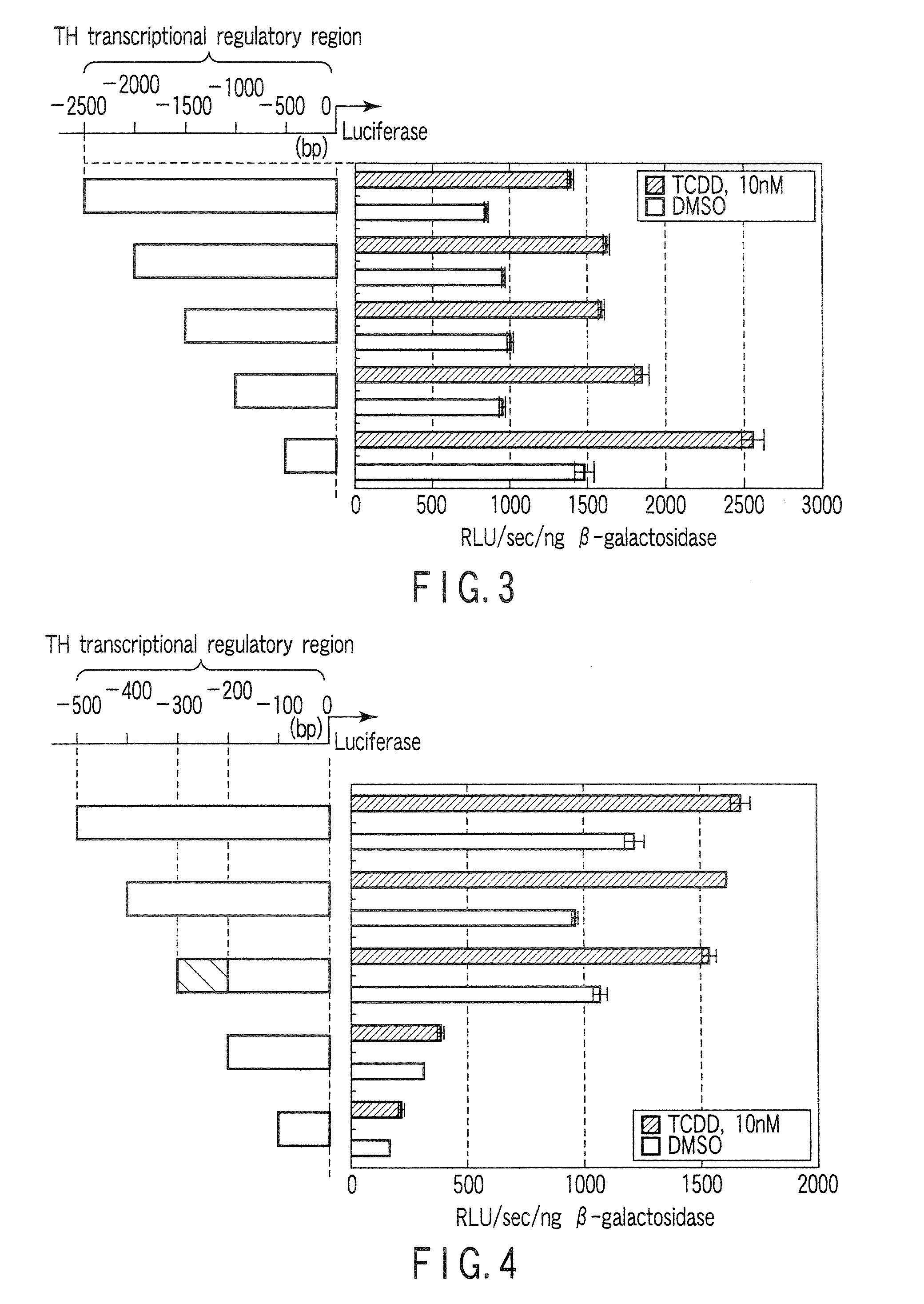Vector and method for detecting the change in transcription amount
- Summary
- Abstract
- Description
- Claims
- Application Information
AI Technical Summary
Benefits of technology
Problems solved by technology
Method used
Image
Examples
example 1
[0068] Preparation of an Expression Vector Carrying an Aryl Hydrocarbon Receptor-Coding Gene
[0069] (a) Preparation of AhR Genes of SD-Line Rat and C57 / BL6-Line Mouse
[0070] Total RNAs were extracted from the SD-line rat brain. The extracted RNAs (template) were subjected to reverse transcription by using oligo(dT) primers. The SD-line rat AhR gene-coding region was amplified from the reverse-transcribed sample by means of PCR (25 cycles of denaturation at 94° C. for 1 minute, annealing at 55° C. for 1 minute, and elongation at 72° C. for 4 minutes) using Pyrobest DNA polymerase (Takara Bio Inc.). The following primers specific to the SD-line rat AhR gene were used. Recognition sequence for restriction enzymes HindIII (for forward primer) and recognition sequence for restriction enzymes XhoI (for reverse primer) were added to the 5′-terminal of the primers, respectively, for the purpose of facilitating incorporation of the PCR product into the vector.
Forward primer:(SEQ ID No: 12)...
example 2
[0078] Preparation of Vector (PGV-THp25) having TH Transcriptional Regulatory Region
[0079] Approximately 2.5 kbp of a transcriptional regulatory region of tyrosine hydroxylase (TH) gene was amplified by means of PCR using a mouse genome (Clontech) previously digested with a restriction enzyme KpnI as a template (SEQ ID No: 1). Recognition sequence for restriction enzymes KpnI (for forward primer) and recognition sequence for restriction enzyme NheI (for reverse primer) were added to the 5′-terminal of the primers for PCR, respectively, in order to facilitate incorporation of the PCR product into the vector.
Forward primer:(SEQ ID No: 16)5′-CGCGGTACCCTTCTCTGTGCCCACAGATGCTTTA-3′Reverse primer:(SEQ ID No: 17)5′-GCAGCTAGCAAGCTGGTGGTCCCGAGTTCTGTCT-3′.
[0080] An α type heat-stable DNA polymerase (Pyrobest DNA polymerase, Takara Bio Inc.), which has a proofreading function and has less mutation frequency during DNA replication, was used as the PCR enzyme. The TH transcriptional regulatory...
example 3
[0081] Measurement of Activity of TCDD on Transcriptional Regulation by Using PGV-THp25-Introduced Cell (Measurement of Transcription Amount of Reporter Gene after Addition of TCDD by Using PGV-THp25-Introduced Cell)
[0082] In this Example, the PGV-THp25 prepared in Example 2 was used. Neuro2a was used as the cell.
[0083] Two kinds of vectors, pcDNA4-rAhR (Example 1) and pcDNA4 / V5-His / lacZ (Invitrogen), were introduced into Neuro2a, together with PGV-THp25. pcDNA4-rAhR was introduced for constitutive expression of the SD-line rat AhR gene (SEQ ID No: 10) in the cell, and pcDNA4 / V5-His / lacZ was introduced for normalization of the vector transfection efficiency.
[0084] The vectors were introduced into the cell by using Lipofectamine 2000 (Invitrogen). The cell was cultured on a 24-well plate, and the operation was performed according to the manual of Invitrogen. A total of 0.8 μg of vectors (0.4 μg of PGV-THp25, 0.2 μg of pcDNA4-rAhR, and 0.2 μg of pcDNA4 / V5-His / lacZ) suspended in 50 ...
PUM
| Property | Measurement | Unit |
|---|---|---|
| Fluorescence | aaaaa | aaaaa |
Abstract
Description
Claims
Application Information
 Login to View More
Login to View More - R&D
- Intellectual Property
- Life Sciences
- Materials
- Tech Scout
- Unparalleled Data Quality
- Higher Quality Content
- 60% Fewer Hallucinations
Browse by: Latest US Patents, China's latest patents, Technical Efficacy Thesaurus, Application Domain, Technology Topic, Popular Technical Reports.
© 2025 PatSnap. All rights reserved.Legal|Privacy policy|Modern Slavery Act Transparency Statement|Sitemap|About US| Contact US: help@patsnap.com



